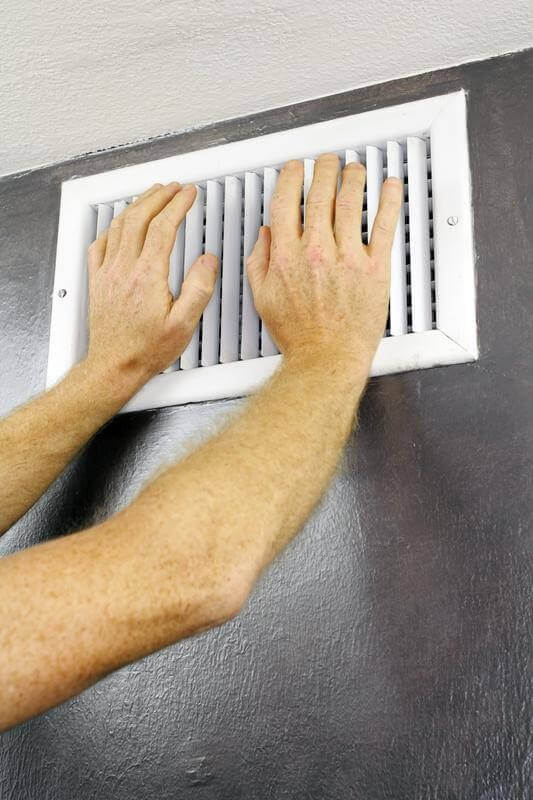Help You?
CLICK TO LEARN MORE ABOUT IRA REBATES AND TAX CREDITS
WHY IS MY FURNACE BLOWING COLD AIR IN ELGIN, IL?
Three Reasons Your Furnace is Blowing Cold Air (And What to Do About It)
- There’s a Problem With Your Thermostat
- Your Vents are Blocked
- The Furnace is Oversized
- There’s a Ductwork Leak
Nothing can make your Elgin, IL home more uncomfortable in the winter than cold air coming out of your vents.
After all, it’s freezing outside. You want your home nice and warm.
In this post, we’re looking at the possible reasons your furnace is blowing cold air in the winter. In some cases, it’s an easy problem you can fix yourself. In others, you’ll need a professional.
If it’s more than you can take care of yourself, give Compass Heating and Air a call. We have a great reputation across the Fox River Valley.
There’s a Problem With Your Thermostat

If you’re getting cold air when you need heat, the problem could be a miscommunication between the thermostat and your system. In this case, you want to check the temperature gauge.
Sometimes, it’s on the wrong setting. Other times, it’s not measuring the temperature correctly or sending the right signals.
As a result, it could be kicking on your central air instead of the heat. Or, it does not recognize that your house is now warm enough. So, the heat keeps coming — until there’s too much.
So, if you’re getting cold air when you want warmth, this is an excellent place to start investigating.
Troubleshooting Your Thermostat
First off, make sure your thermostat is set properly. You’d be surprised how often your only “fix” is to switch the setting from “Cool” to “Auto” or “Heat.”
If that doesn’t do the trick, you can check to see if it measures heat accurately.
To do this, tape a regular thermometer next to the thermostat on the wall. Then, set the thermostat a few degrees above the reading you get from the thermometer.
If the heat doesn’t click on quickly, then you’re getting a bad reading. Now might be the time to invest in a new, and better, smart device.
Your Vents Are Blocked
Here’s the problem: A blocked vent means air won’t circulate properly. And, if your system is the right size for your home, now there’s too much heated air.
And it has to go somewhere.
Many times, it can redistribute in other parts of the house. But, if there’s already enough forced air in those areas, it backs up into furnace.
Now, even though your HVAC system is responsible for generating heat, you still don’t want it to get too hot inside.
After all, it forces all that thermal energy out. It doesn’t store it.
When it gets too hot in there, the inner components can start to break. So, the system has a failsafe: It switches to cold air.
At this point, your system stops producing warm air. And, it cools down to prevent any damage.
But for you, that means cold air circulating through the house when it’s already freezing outside.
Fixing A Blocked Vent
Yes, this may mean rearranging a room or two. But, it also means not getting a blast of frigid air through the house.
Also – make sure all your vents are open. Yes, older homes have tabs on the vents so you can close them off. But, it’s not a great idea to use those.
The Furnace is Oversized
The concept here is about the same as the blocked vents. Only, it’s on a much larger scale.
When your furnace is too powerful, it pushes more heated air than the house needs. The house gets warm very quickly. But, there’s still more heat coming through the vents
Of course, your thermostat will tell the heating system to shut off once you get the temperature you want. But, by then, it’s already getting too hot.
And, once again, the thermal energy backs up into the system. Then, you end up with the overheating problem again.

How Can I Fix An Oversized Heater?
The bad news is, there’s really no way to “fix” a furnace that’s too big for your home. Unless you have a two-stage system, it only has two modes: “Off” and “Maximum Power.”
Still, you want to remedy the situation. Otherwise, there’s a good chance your furnace will break down years earlier than it should.
All the sudden changes from hot to cold cause extra stress on the inner components. And, they get worn down from stopping and starting too often.
If your system is on the way out anyway, make sure your HVAC contractor does a proper load assessment next time. This way, you get a system that’s the right size for your house.
If you’re stuck with a system that’s too large for a few more years, you can consider extending the ductwork and adding vents.
This strategy gives some of that extra forced air a place to go. This way, it doesn’t back up into the system.
However, it’s an expensive move. So, either way, your best bet is to speak with a professional about your options.

